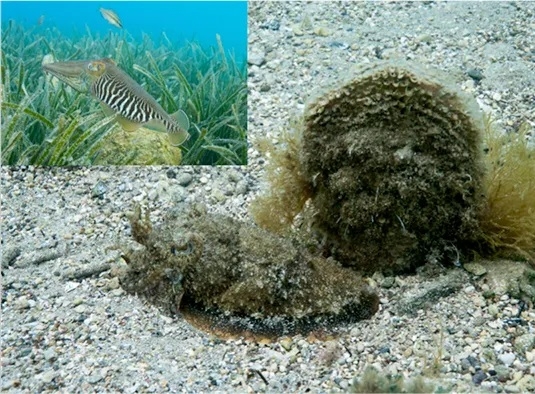Cuttlefish Masquerade as Objects by Morphing their 3D Skin

Look again at that spiky, algae-covered rock as it stirs and unfurls its arms: It’s not a rock at all, but a cuttlefish in disguise.
New research by MBL Senior Scientist Roger Hanlon and colleagues describes a rare form of “masquerade” camouflage in which cuttlefish change the bumpiness of their skin to resemble an inanimate object, like a rock. Their study is published today in Biology Letters.
“We demonstrate how refined, robust and repeatable this behavior is; cuttlefish cross an open area to settle next to a rock, then adjust their camouflage pattern to match the rock and also finely adjust the 3D texture of their malleable skin to imitate the rock’s physical texture,” Hanlon says.
A relative of the octopus, cuttlefish control their skin texture through many small sets of muscles in their skin, called papillae. These papillae can be flexed to imitate an array of surfaces—from the spikiness of barnacles to the smoothness of a rock, accompanied by skin color changes to resemble the object with striking fidelity.

The authors tested this system by observing the reactions of 15 cuttlefish to two different rocks—one smooth and white, and the other rough and mottled. No matter which rock was placed in their habitat, the cuttlefish always moved away from the wall and across the tank to the rock to use it as a disguise. The animals then consistently demonstrated the same texture as either rock, often without touching them, suggesting a visually guided expression.
Cuttlefish and octopus are the only animals known to demonstrate this method of masquerade.
“By all measures, these are the most diverse, dynamic camouflaging animals that have evolved on this planet,” Hanlon said. “That’s why I do a lot of field work. My inspiration comes from diving where the animals live and immersing myself in their sensory world.”
Citation:
Deanna Panetta, Kendra Buresch and Roger T. Hanlon (2017) Dynamic Masquerade with Morphing Three-Dimensional Skin in Cuttlefish. Biology Letters DOI: 10.1098/rsbl.2017.0070